MSI GT73VR Titan GTX 1070 SLI Gaming Laptop Review
Peter Donnell / 7 years ago
Introduction

Getting massive amounts of performance from a desktop system is easy, you just buy the big graphics cards, the big power supply, big coolers, and plug it all in. Trying to get massive amounts of power in a laptop form factor, however, is not so easy. The latest system from MSI is designed for those who need something that’s just as powerful as an enthusiast grade desktop system but has just enough portability to be mobile. While at its heart this is setup in a way to be a powerful gaming system, it’s configuration means it’ll power through workstation tasks, rendering, even scientific applications if you really need to. Of course, all this performance doesn’t come cheap, and you won’t be getting much change from £3000, but do you get good value for money? Let’s take a look!
“MSI is the world’s 1st gaming notebook to have this latest NVIDIA next gen. GPU solution onboard. Performance of NVIDIA’s next generation GeForce® GTX 1080 GPU is expected to improve more than 40% than GeForce® GTX 900M Series. With the innovative Cooler Boost cooling solution and MSI’s special gaming features catered for gamers, the NVIDIA’s latest GeForce® GTX 1080 GPU shall be able to release its full performance completely on MSI gaming laptops. By offering “one click to VR” solution and a totally immersive and smooth gaming experiences, the new MSI gaming laptops is going to shatter desktop performance cliché and amaze gamers with refreshing point of views on MSI gaming laptops.”
Equipped with a powerful Intel CPU, dual Nvidia GTX 1070 graphics cards, dual NVMe M.2 drives in RAID 0, and high-performance DDR4 memory, this beast of a laptop should have no issues with demanding workloads or games. It should look great too, with a 3840 x 2160 display, capable of displaying 100% of the Adobe RGB range, although you can get a 120 Hz 1080p option too.
- Windows 10 Home / Windows 10 Pro
- Latest 6th Gen. Intel® Core™ i7 processor
- Latest GeForce® GTX 1070 (SLI)
- 17.3″ built-in 4K LCD with 3840 X 2160 resolution and 100% Adobe RGB
- Exclusive Cooler Boost Titan Technology
- The X Boost function from MSI technology supports faster storage access speed.
- Dragon Center provides six functions to get a total control of your personal computer
- WTFast free premium license for 2-month
- Exclusive Super RAID 4 (Dual NVMe M.2 SSDs by PCIe Gen3 X4 in RAID 0)
- Thunderbolt™ 3 supporting 40Gbps ultra speed data transfer rate, 4K monitor output, and portable charging power up to 5V/3A (optional)
- USB Type-C reversible plug
- Easy Overclocking with MSI SHIFT Technology
- Exclusive ESS SABRE HiFi DAC for lossless, high-quality audio
- Nahimic 2 Sound Technology delivering 360⁰ immersive audio experience
- Sound by Dynaudio system
- True Color Technology for increased color contrast and greater image detail
- Keyboard by Steelseries with full color backlighting
- SteelSeries Engine 3 with GameSense to personalize your play style
- Exclusive Silver Lining Printed keys
- Killer DoubleShot Pro (Killer Gb LAN + Killer 802.11 a/c WiFi) with Smart Teaming
- Upgraded Killer Gigabit LAN Controller with Advanced Stream Detect 2.0 and Killer Shield
- Xsplit Gamecaster free premium license for 1 year
- Matrix Display supporting surround mode and 4K output up to 3 external monitors
- Brushed-metal lid and aesthetics line design imprinted with MSI iconic Dragon Tatoo, unleashing the true dragon gaming soul
Packaging and Accessories
The box for the GT73VR Titan is huge, which is to be expected given the 17.3″ laptop housed within. The box is very tough too, which should keep the hardware safe while in transit.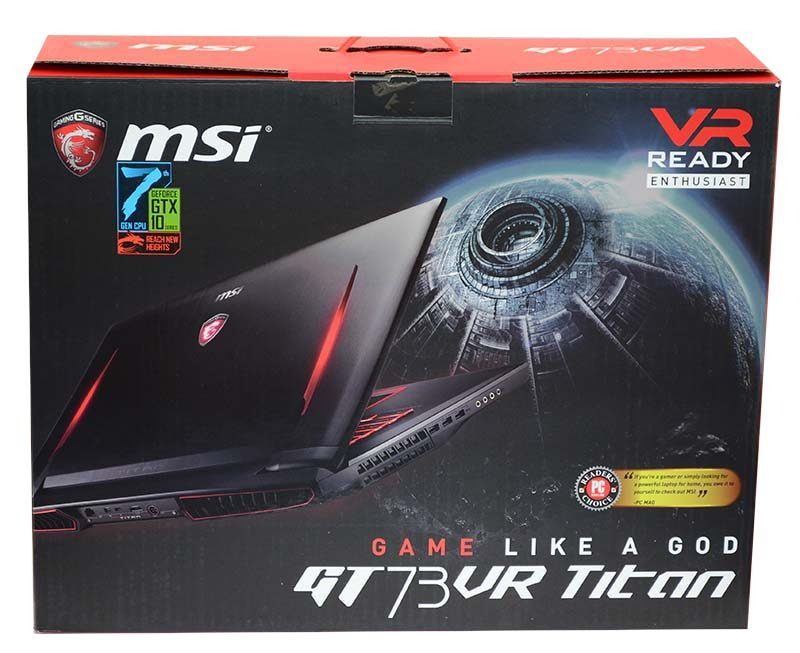
All the features are detailed on the box, although not all are relevant to this model as some features are optional (display type, CPU, HDD configuration, etc.)
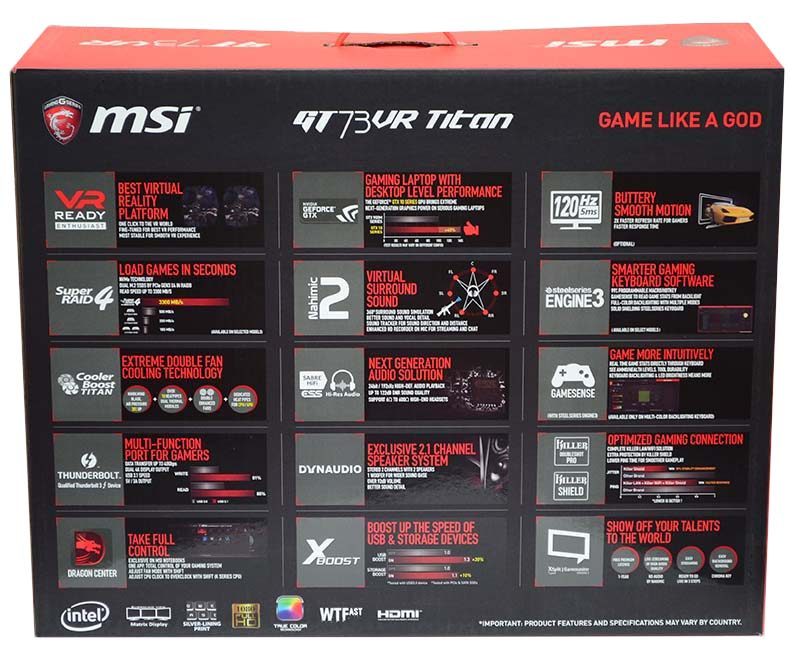
In the box, you’ll find the laptop, of course, as well as this rather terrifying looking power adapter configuration. There are two power bricks which are wired together with a Y-splitter, and require two plugs from your mains supply.
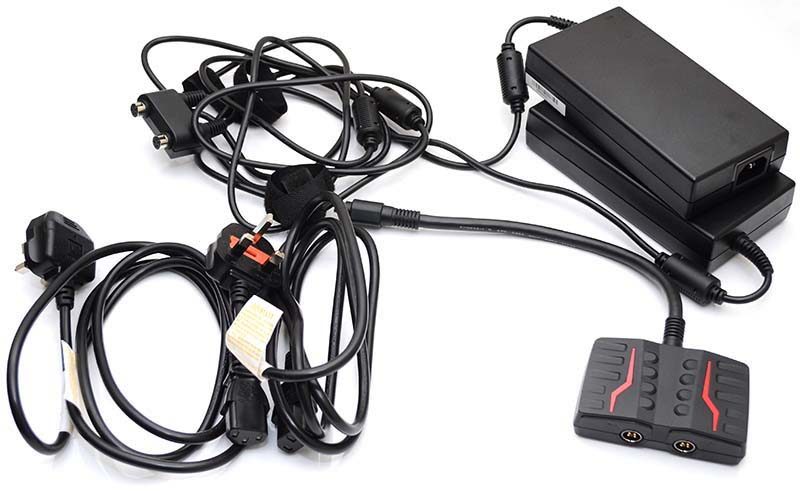
Both power bricks then connect into a power hub, which feeds both supplies through a shorter heavy duty power cable that plugs into the laptop… that’s pretty hardcore, and should be your first sign that this system is no joke when it comes to power.
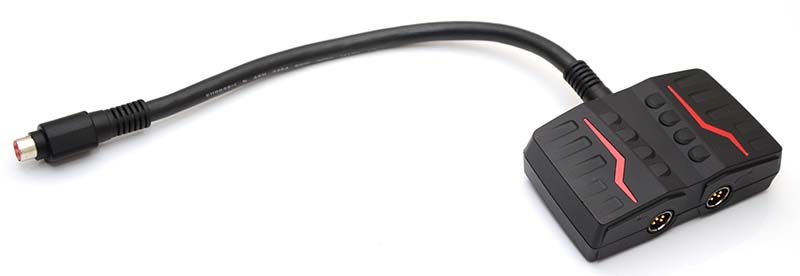
You’ll also find a collection of documentation for warranty, setup, the usual stuff really, it’s all pretty straightforward.
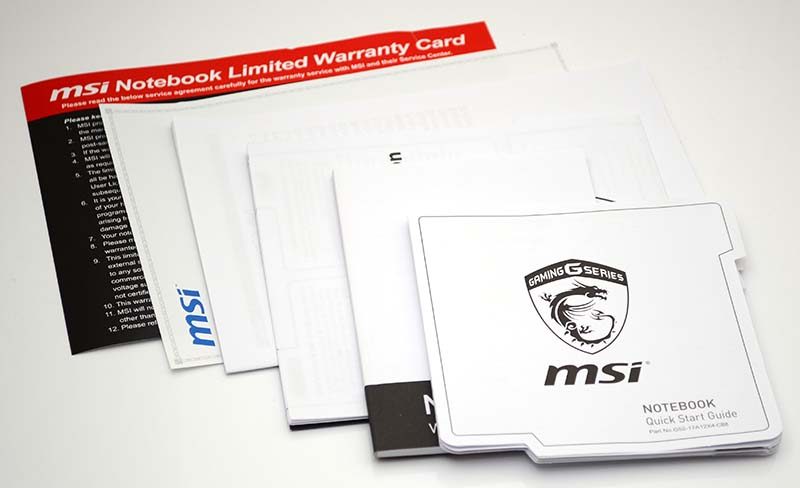
A Closer Look
The first thing that stands out about the Titan is the size, this isn’t the kind of laptop you’re going to want to carry around all day long, that’s for sure. It’s big, it’s pretty damn heavy, and it’s more suited to those who need to take it home at the end of the day, or keep it in the boot of their car rather than providing true mobility.
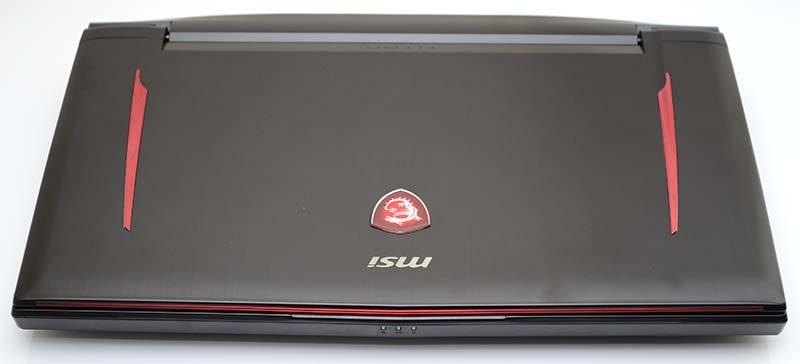
The design looks great, and while it is quite thick, that depth means lots of room for cooling. There’s a large vent on each side, and plenty more around the back and on the base to keep the high-end hardware housed within nice and cool. Down the right side, you’ll also find 2 x USB 3.0 ports, as well as a built-in SD Card reader.
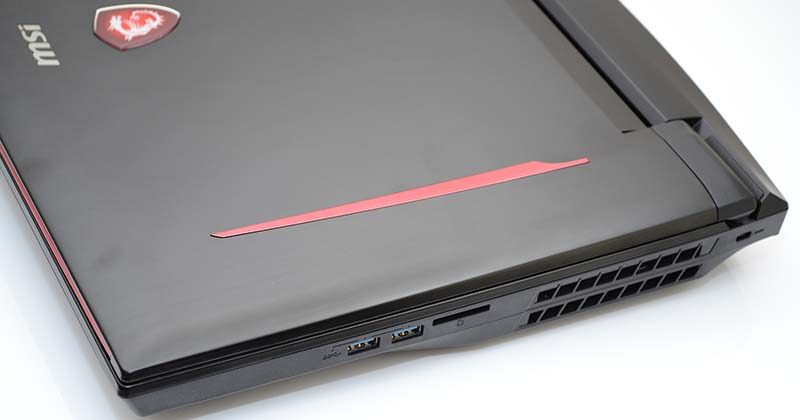
Down the left side, there are 3 x USB 3.0 ports and four gold-plated audio jacks.

The front edge is kept nice and tidy, with just a few small LED indicators sitting in the middle.
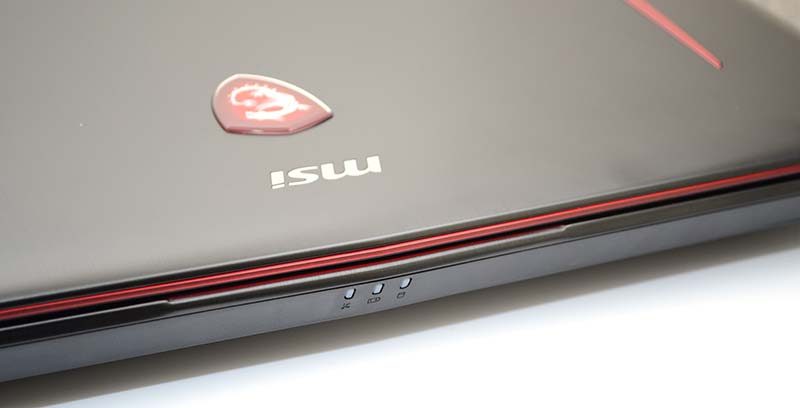
Around the back, an RJ45 port, DP Mini, USB Type C, HDMI (out) and the heavy duty connector for the power cables.
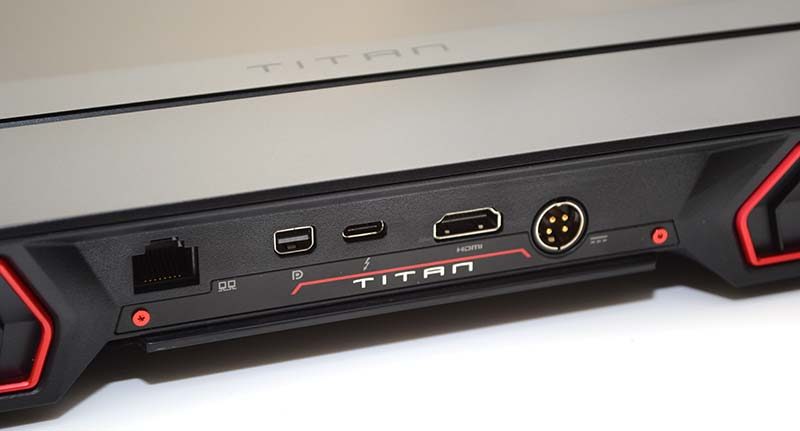
There are two huge vents around the back, which look like the vents on a supercar.
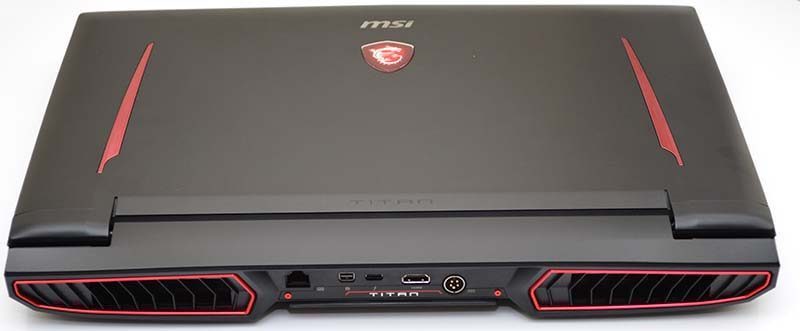
The fins on the back are angled in a way that should help push the air away from the system, rather than have it cycle back into the bottom air intakes and overheat the system.

The size of the Titan brings some nice benefits to productivity, as it’s able to feature a full-size Steelseries keyboard, it’s not mechanical, but it does have a very natural key spacing and great feedback; plus it’s RGB, which is a nice bonus.

The housing has a beautiful brushed metal appearance, quite a durable and quality feel to it; the chassis doesn’t flex when you rest your palms on it.

Most of the primary functions of the keyboard are accessible with FN-Shift, allowing you to tweak the LED brightness and volume levels on-the-fly.

You can toggle system profiles and performance features from the F-keys too, meaning you’ll spend less time tinkering with the desktop software, and more time gaming or working.

The touchpad for the mouse is quite large too, with dedicated left and right buttons for added control.

Should you need it, you’ll also find a built-in HD webcam and microphones at the top of the display; handy for Skype!
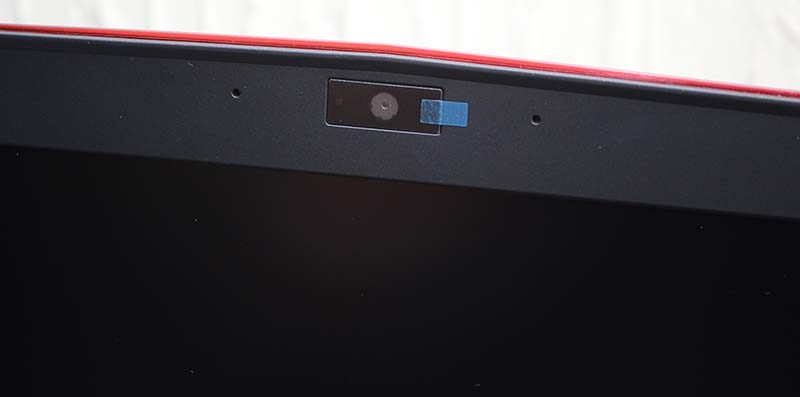
Finally, done the right side, a few dedicated shortcut buttons, as well as the master power button.
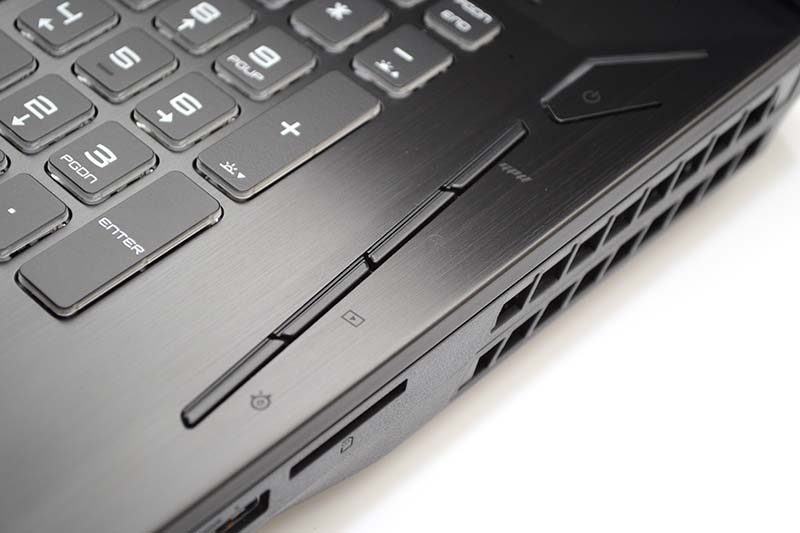
Fire up the system, and you can see that lovely LED lighting on the keyboard, as well as a little trim around the mousepad, giving it a very nice glow that’s easy to see in a dim room. The display is stunning, with deep blacks and very vibrant colours, and so it should be with 100% of the Adobe scale being covered by the 4K panel.
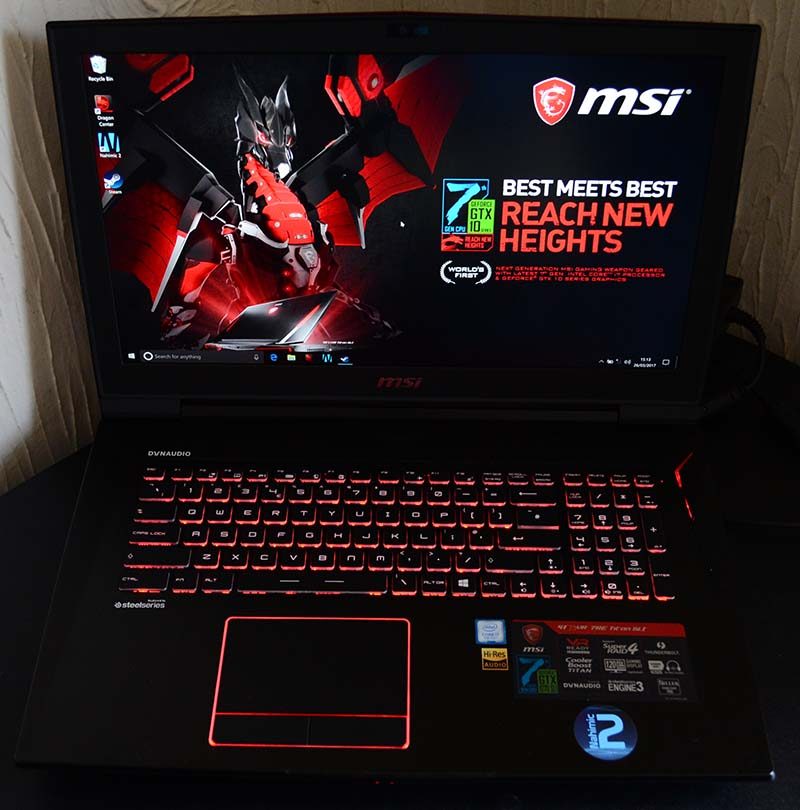
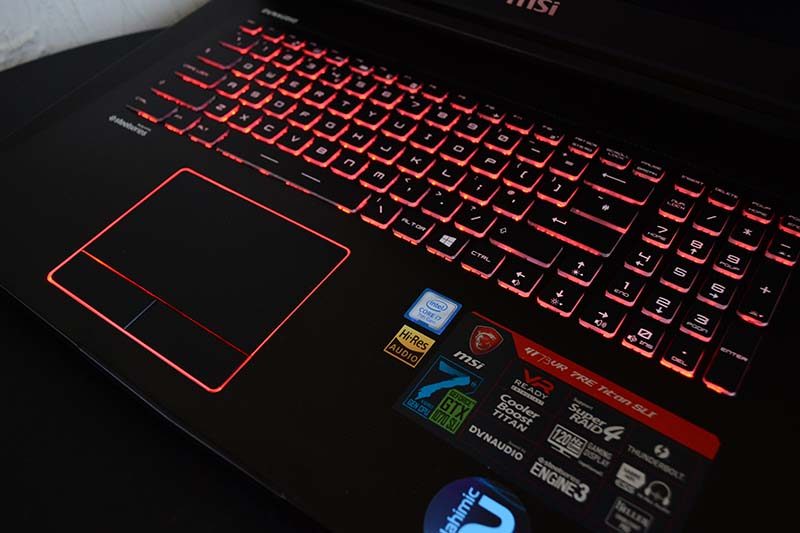
The base of the Titan has a huge amount of ventilation, with air intakes for all the major components, as well as four large rubber feet to give it the ground clearance it needs to take air in too.

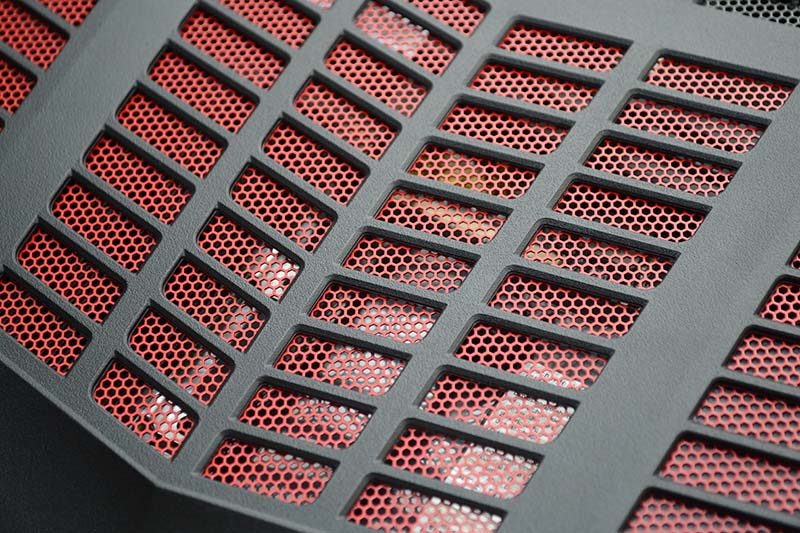
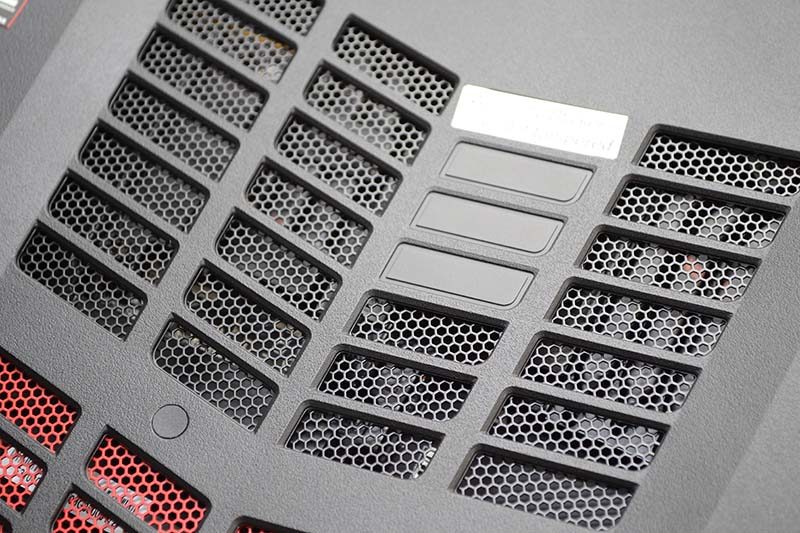
On the front left and right corners, two speakers are mounted, and there’s a built-in subwoofer too; where you see the DynAudio badge.
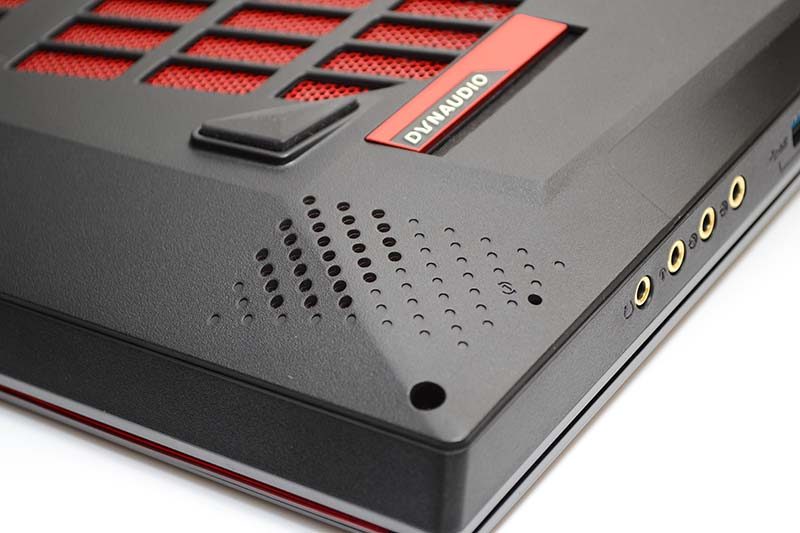
There’s some serious hardware in this laptop, and that means there are some equally serious cooling requirements. As you can see, there are heat pipes running all over the place, from the two graphics cards (front left and back right), the processor (back left), and there’s even some passive heat fins fitted over the HDD array near front centre. Everything is piped through to the two massive blowers in the back corners to exhaust through the large rear vents.
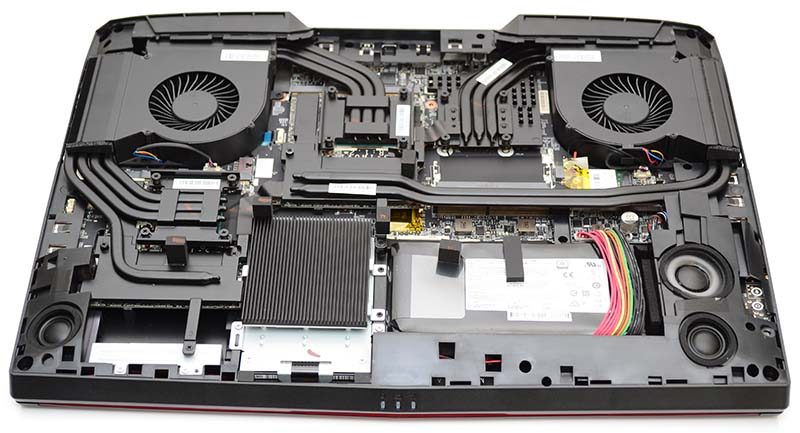
Under this block, you’ll find the dual M.2 SSDs.

A close up of one of the GPU blocks, which an additional heat pipe breaking off to cool surrounding hardware on the motherboard.
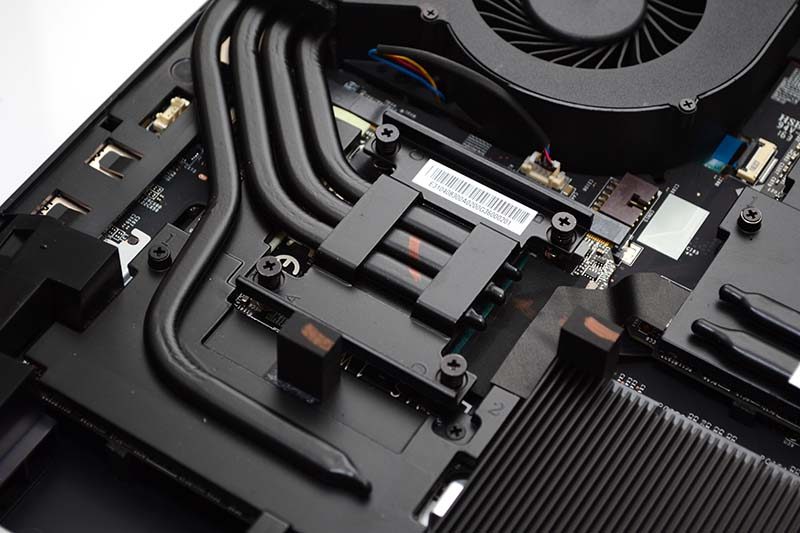
Another three heat pipes for each block on the CPU and the other graphics card, which two more providing additional cooling to other motherboard components such as the VRM and memory.
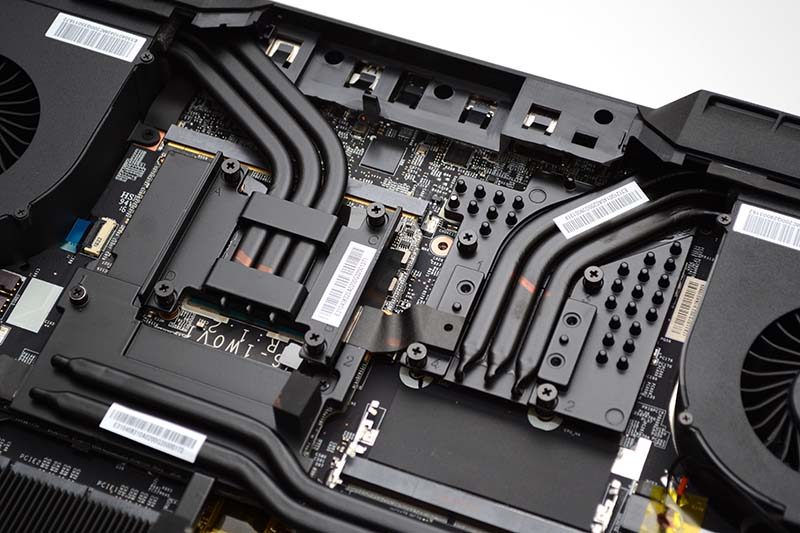
Tucked in near this cooler, you can also see a wireless M.2 card.
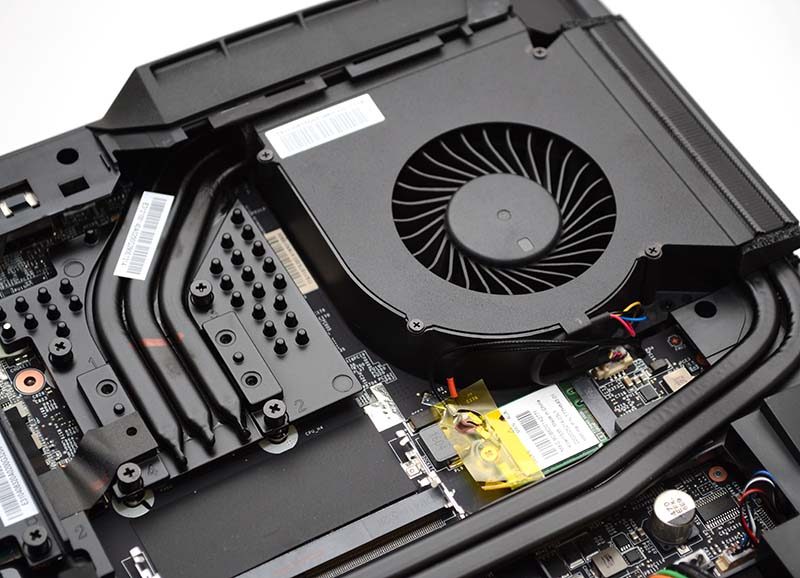
The battery is quite small, but even with a big battery, the hope of running this kind of hardware for very long would be crazy, although it’s estimated you could get around 90 minutes of day-to-day use with this, and drastically less if you’re gaming.

Testing & Methodology
To test each system or notebook, we want to stress every component of the system to check stability and performance, giving us an idea as to why those particular components were picked for this particular system. We use a wide variety of applications to gain a broad spectrum of results for comparing diverse aspects of system performance.
Unless specifically stated, all games are running at maximum settings but any vendor-exclusive features such as TressFX or PhsyX have been disabled to make the results fair. There are some titles where the maximum preset can be altered further in regards to AA, AF, Tessellation, and Draw Distance. To allow our readers to make the most informed decision, any additional options will be clearly labelled in this section. Please note each benchmark is run three times to maintain the highest level of accuracy.
Hardware
- Acoustic dBA meter
- AC “Killawatt” power meter
Software
- 3DMark
- AIDA64 Engineer
- Cinebench R15
- CrystalDiskMark
- CPU-Z
- GPU-Z
- HW-Monitor
- MSI Afterburner
- Passmark PerformanceTest 8.0
- PCMark 8
- Prime95
- WPrime
- Unigine Heaven 4.0
- Grand Theft Auto 5
- Rise of the Tomb Raider
- Hitman
- Far Cry Primal
PC Mark 8
The PCMark 8 Home benchmark includes workloads that reflect common tasks for a typical home user. These workloads have low computational requirements making PCMark 8 Home suitable for testing the performance of low-cost tablets, notebooks, and desktops. Home includes workloads for web browsing, writing, gaming, photo editing, and video chat. The results are combined to give a PCMark 8 Home score for your system. Download here.
3D Mark
The new 3DMark includes everything you need to benchmark your hardware. With three all new tests you can bench everything from smartphones and tablets to notebooks and home PCs, to the latest high-end, multi-GPU gaming desktops. Download here.
Grand Theft Auto V
Our GTA5 Benchmark is run on the standard benchmark with MSAA=Off, FXAA=On, Advanced Graphics Disabled and everything else set to their maximum values:

Rise of the Tomb Raider
Even though Rise of the Tomb Raider recommends graphics cards above 4GB for the Very High preset, we believe it’s the best option to stress graphics cards and distinguish between systems opting for different hardware. Of course, lower-end hardware can struggle with the benchmark and output some unusual results. FXAA is also enabled.
Hitman
To properly test DirectX 12 performance, the integrated Hitman benchmark is used and everything is set to maximum with FXAA set to on.
Far Cry Primal
In this game, the Ultra preset is selected with the HD texture pack and FXAA. Once the settings have been dialled in, the game’s built-in benchmark is run three times with an average taken to display the performance.
Cinebench R15
Cinebench is a widely respected benchmark for testing the performance of x86 CPUs. The program allows you to test single and multi-threaded performance as well as GPU performance by rendering with Open GL. Download here.
Super Pi
Super PI is a single threaded benchmark that calculates pi to a specific number of digits. Super PI is a single threaded benchmark ideal for testing pure, single threaded x87 floating point performance and while most of the computing market has shifted towards multithreaded applications and more modern instruction sets, Super PI still remains quite indicative of CPU capability in specific applications such as computer gaming. Download here.
AIDA64 Engineer Edition
AIDA64 Engineer is a streamlined Windows diagnostic and benchmarking software for engineers. It has unique capabilities to assess the performance of the processor, system memory, and disk drives. AIDA64 is compatible with all current 32-bit and 64-bit Microsoft Windows operating systems, including Windows 8 and Windows Server 2012. Memory and cache benchmarks are available to analyze system RAM bandwidth and latency. Download here.
CrystalDiskMark
CrystalDiskMark is a portable storage drive benchmark utility that enables you to measure sequential and random read/write speeds on different block size data. CrystalDiskMark will work with any storage drives including hard drives, SSDs and USB flash drives. Download here.
Passmark
The PassMark Advanced Network Test (which is part of PerformanceTest) is designed to test the data transfer rate between two computers both of which must be running PerformanceTest. One of the computers must act as the server and will sit waiting for a connection. The other computer acts as a client. It connects to the server machine and sends data to it for the duration of the test. You can download a trial version of PerformanceTest from here.
Acoustic Performance
The amount of noise produced by any computer is a vital consideration for most buyers, even gamers don’t really want a noisy PC because less noise is always better. We use an acoustic dBA meter held 2 feet behind our test system at idle and under load to get the idle and load noise levels for the system. For idle we allow the system to sit at the Windows desktop, for load we let Unigine Heaven 4.0 and Prime95 to loop together – we take the acoustic measurements 5 minutes into both of these scenarios.
Power Consumption
To test power consumption we measure the total system power draw during idle and load scenarios. For idle we allow the system to sit at the Windows desktop, for load we let Unigine Heaven 4.0 and Prime95 to loop together – we take the power measurements from the “Killawatt” AC power meter 5 minutes into both of these scenarios at the same point.
Temperatures
To test thermal performance we measure average CPU and GPU core temperatures during idle and load scenarios. For idle we allow the system to sit at the Windows desktop, for load we let Unigine Heaven 4.0 and AIDA64 to loop together – we take the temperature measurements from within CPUID HWMonitor 5 minutes into both of these scenarios at the same point. For load we take the average of the maximum temperatures, for idle we take the average of the minimum temperatures.
Synthetic Benchmarks
PC Mark 8
A pair of high-end graphics cards, as well as the i7-7820HK, allow the Titan to clock a score that goes head to head with powerful desktop systems, very impressive.

3DMark
When it comes to 3DMark, the Titan put out the second highest Extreme score for 3DMark of any system we’ve ever tested.

Gaming Performance
Grand Theft Auto V
GTA V is a very demanding game, yet the Titan managed to exceed 100FPS in both 1080 and 1440 test, and an extremely impressive 85FPS at 4K; it makes it look easy!

Rise of the Tomb Raider
While the system didn’t put out the best 1080P scores we’ve seen, it managed to set a new record for 1440 and 2160P; without a doubt, this is a seriously powerful gaming rig.

Hitman
Hitman didn’t fair as well as the others, but still above 60FPS in 1080 and 1440P tests, and a respectable 45FPS while running at 4K.
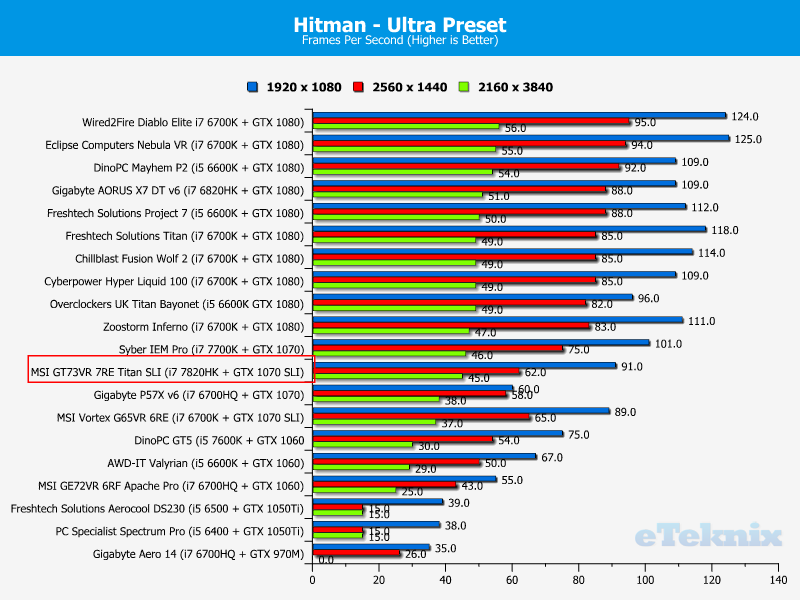
Far Cry Primal
Again we see MSI dominating the top of the chart for 4K performance, although the 1080P performance still doesn’t seem to scale well with the SLI configuration.

CPU & Memory Performance
Cinebench R15
If you plan on using this system for a bit of rendering, it’s certainly competitive, clocking in a score that beats out any GTX 1080 equipped laptop and coming in just behind all GTX 1080 powered desktops.
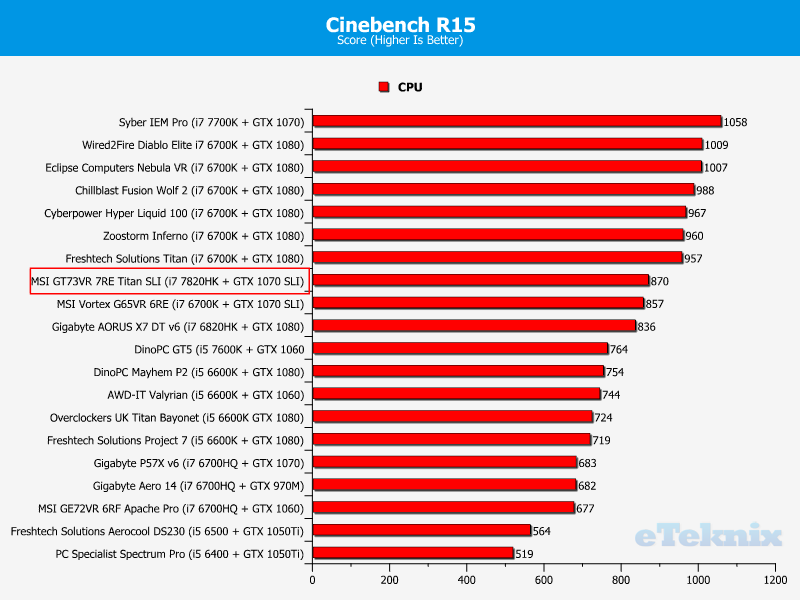
WPrime
The i7 is a good number cruncher and set our fastest WPrime score for a laptop at 1024M.
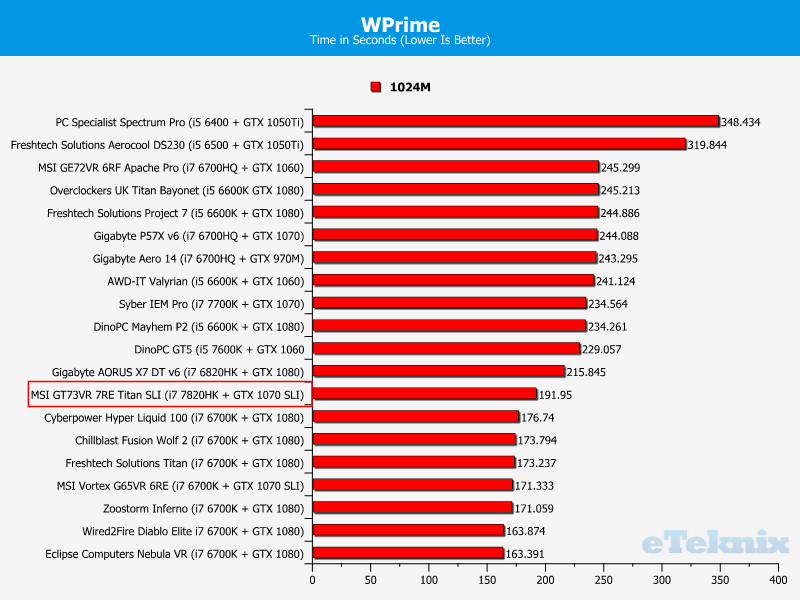
AIDA64 Engineer
Memory performance is right where we would expect it to be, delivering fast read, write, and copy times.
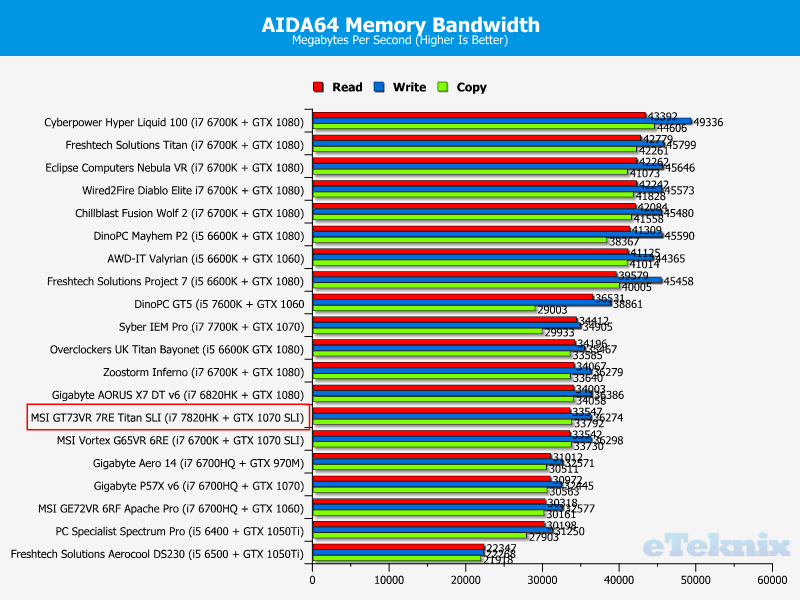
Storage and USB Performance
CrystalDiskMark – Sequential Read
Why would you want to invest in a RAID 0 configuration of two M.2 drives? This is why! The Titan smashed through this benchmark, giving some terrifyingly fast read speeds that are sure to speed up the loading of… well, everything.

CrystalDiskMark – Sequential Write
Write times aren’t exactly lacking either, scoring almost double of the next fastest write speeds we’ve ever recorded in a system review.

Networking Performance
Passmark PerformanceTest 8.0
Ethernet (LAN)
The Gigabit LAN didn’t melt our faces like the other scores have done, but this is right where it should be delivering consistent speeds overall.

WiFi
The Wi-Fi could be a bit faster, but again this is still a perfectly good score.
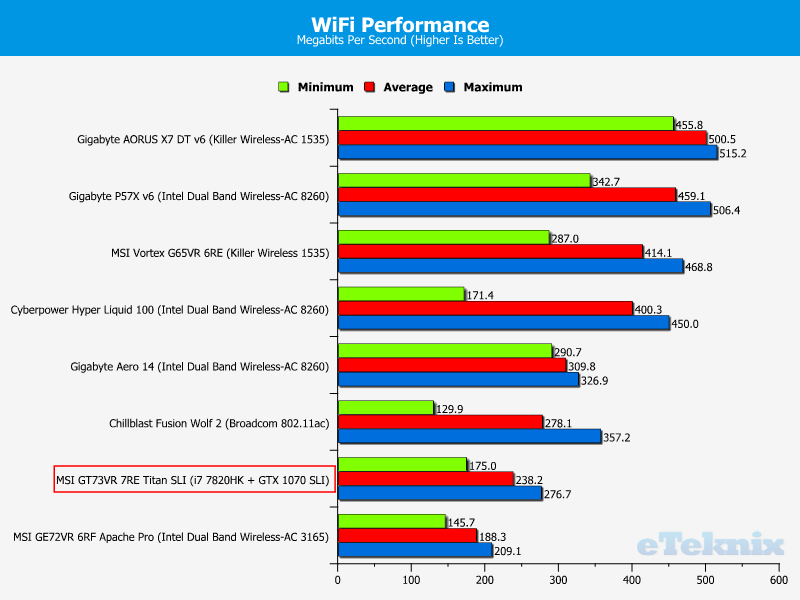
Battery, Acoustic and Thermal Performance
Battery Life
Battery life is.. well it’s not great, but with such high specifications, this is hardly surprising. A bigger battery would make an already fairly impractical laptop even heavier and more expensive for very little benefit, so it’s best to keep those power cables plugged in while performing demanding tasks.

Acoustic Performance
At idle, the system is much quieter than I expected, and while it is a little noisy as full power, it rarely reaches these levels in day-to-day gaming tasks.
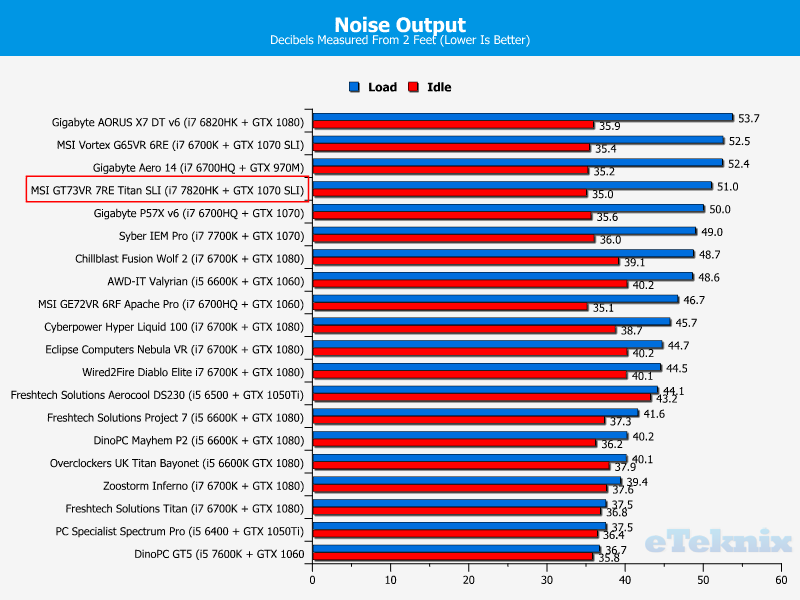
Thermal Performance
The cooling hardware certainly does a good job, clocking in much cooler than I expected, showing that the large cooling solution on the interior does a fantastic job overall.
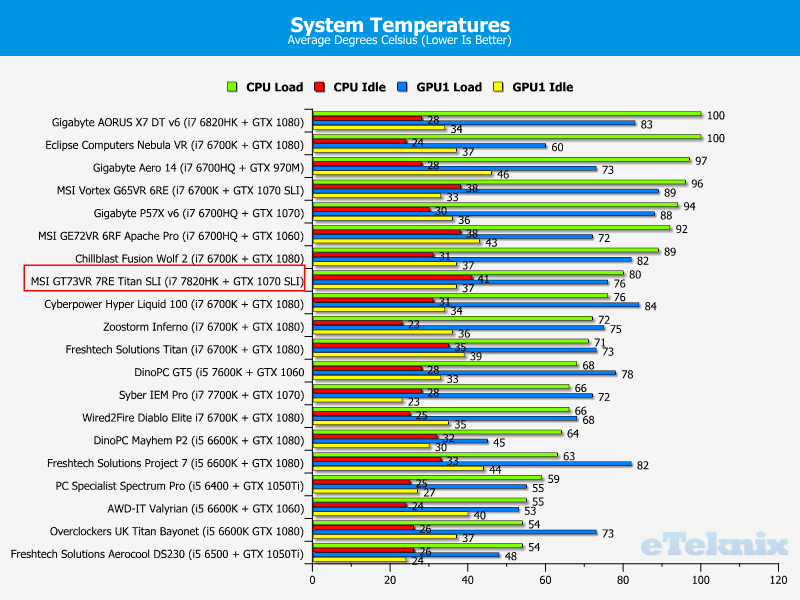
Final Thoughts
Video Review
Pricing
Despite being limited to a laptop form factor, this is one of the most powerful and fastest systems we’ve ever tested, and as such, it comes with a price tag to match its larger than life performance. The 1080P version equipped with a 120Hz display will cost you £2299.99, which the 4K screen equipped version we tested today is £2867.99. This obviously isn’t cheap, but looking at the features and the performance figures, it’s not like you don’t get a lot for your money!
Overview
Where do I even start with this system, on the one hand, it’s completely mental, and on the other, it’s utterly brilliant! The first thing to deal with is the price, £3000 is not a small amount of money, and it’s obviously not priced for your day-to-day consumer. This is some serious hardware for those who need extreme performance in a vaguely portable format. I can see something like this appealing to those who develop games, want a portable VR gaming demonstration system, or just those who don’t want any compromises in terms of gaming performance when they’re away from home or at the office.
In terms of productivity, it is awards all round for the Titan. It’s got a full-size keyboard, excellent connectivity, can support multiple external displays, can deliver frightening frame rates even at 4K resolutions, it’s got a screen with incredible colour accuracy, powerful speakers that are great for media consumption, a powerful processor, extremely fast M.2 performance thanks to its RAID 0 configuration. The list goes on and on, and when it comes to getting your work done, the only thing that’ll slow you down is nipping to grab a cup of coffee, but certainly not the Titan.
For a system with this level of hardware and performance, it runs surprisingly cool and quiet. That’s not to say it is cool and quiet, but more so than you would expect, and it shows that MSI has put a lot of thought into the cooling configuration of this laptop. The extensive heat pipe design does keep it cool but plays no small part in the overall weight of the system. You’ll want a pretty sturdy backpack to lug this beast around, although, with a short battery life, it’s not truly “portable” like some other laptops.
If you need something that’s big and powerful, but just about small enough to actually be moved around from time to time, the Titan is the way to go. It makes no compromises in performance, it makes no compromises in size, or even in price. It’s one of the fastest and most capable systems we’ve ever tested and so long as you don’t mind finding two plug sockets every time you want to use it, you’ll be extremely impressed with what it has to offer.
Pros
- Choice of 120Hz or 4K panels
- 100% Adobe RGB (4K)
- Extremely fast M.2 RAID 0 storage
- Exceptional gaming performance even at 4K
- Great sound
- Powerful cooling system
- One of the most powerful systems we’ve ever tested
- Full-size keyboard
- Excellent connectivity
Cons
- Requires two power sockets and limited battery life
Neutral
- Quite big and heavy
- Big performance means big retail price

MSI GT73VR Titan GTX 1070 SLI Gaming Laptop Review



















